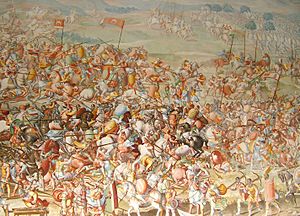Fabrizio Castello facts for kids
Fabrizio Castello (1562–1617) was an Italian painter who moved to Spain. He was known for painting frescoes, which are paintings done on wet plaster. He was especially good at creating decorative paintings called grotesques.

Contents
Early Life and Training
Fabrizio Castello was sometimes called il Figonetto. He was the son of a famous painter named Giovanni Battista Castello. Fabrizio came to Spain around 1567. His father had been asked by Álvaro de Bazán, 1st Marquis of Santa Cruz to work on his palace in Viso del Marqués.
After his father passed away in 1569, Fabrizio was looked after by his half-brother, Niccolò Granello. Niccolò was also a painter and taught Fabrizio the skills of the trade. Records show that in 1576, Niccolò, who worked for the king, increased Fabrizio's pay because Fabrizio was helping him. By October 1577, Fabrizio was old enough to work on his own. He started getting paid 5 reales a day for his work at the Royal Monastery of San Lorenzo de El Escorial.
Starting His Career
Fabrizio Castello was part of a team of artists led by his half-brother, Niccolò. His other brothers also helped. They worked together to decorate different parts of the basilica and Monastery of El Escorial with paintings.
In 1582, Fabrizio and one of his brothers were asked to paint the choir of the basilica. This painting was later replaced by a work by Luca Cambiasi. It's also thought that between 1583 and 1584, Fabrizio helped decorate the ceilings of the vestry and sacristy of the monastery. Some of the figures painted there might have been done by him, but the official records only mention his half-brother.
Working with Other Artists
In June 1584, Fabrizio Castello became a painter for the king. He earned 16 ducats each month. In December of the same year, he was asked to paint the ceiling of the Queen's chambers. This area later became known as the Gallery of Battles.
He worked on this project with his brother, Luca Cambiasi, and Cambiasi's son, Orazio Cambiasi, and Lazzaro Tavarone. They painted amazing and symbolic designs, inspired by Perino del Vaga. In just six months, these four painters finished painting the nearly 200-foot-long room. They were paid a large sum of 1000 ducats for their work.
After this, the same team painted the ceilings of two other rooms. They also retouched paintings in a hall, which kept them busy for the next year. In January 1587, they were hired to paint a large fresco of the Battle of La Higueruela in the same room. This was a different kind of painting than the grotesques they usually did. For this battle scene, they used an old painting found in the Alcázar of Segovia as a guide. Fabrizio had restored this old painting in 1581.
After finishing the battle painting, in September 1589, Fabrizio, Niccolò Granello, and Lazzaro Tavarone began painting the remaining walls. Luca Cambiasi had returned to Italy by then. They painted the first four scenes about the Battle of St. Quentin. Even before finishing these, Fabrizio started working on painting more grotesques in February 1591.
Family Life
Fabrizio Castello was married to Catherine Mata. Their first child was born in El Escorial in 1586. Another painter from his team, Juan Serrano, who was related to his wife, was the godfather. In 1595, while living in Madrid, another son was born. This son, Felix Castello, also became a painter, following in his father's footsteps.
See also
 In Spanish: Fabrizio Castello para niños
In Spanish: Fabrizio Castello para niños
- Brown, Jonathan, The Hall of Battles of El Escorial: the work of art as a cultural artefact, Ediciones Universidad de Salamanca, 1998, ISBN: 84-7481-885-0
- Garcia-Frias Checa, Carmen, "Artists Genoese decorative painting grotesques of the Monastery of San Lorenzo de El Escorial" in Colomer, José Luis, dir., Spain and Genoa: Works, artists and collectors, Madrid, 2004, ISBN: 84-933403-4-0
- Newcome, Mary, "Genoese fresco painters in El Escorial" in Giampaolo, Mario, coord., Italian frescoes of El Escorial, Madrid, Electa, 1993, ISBN: 84-8156-056-1

